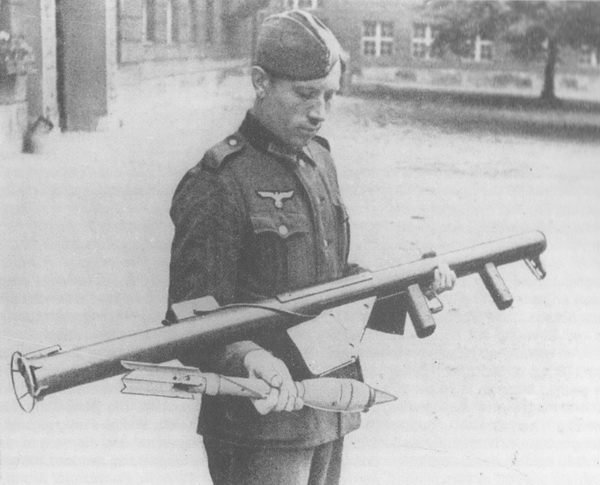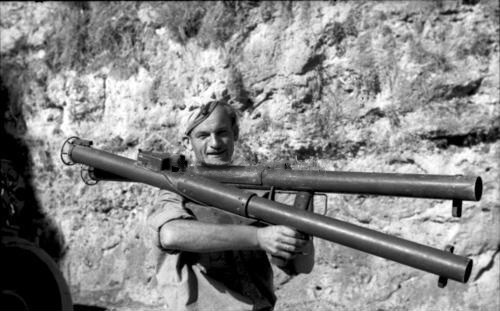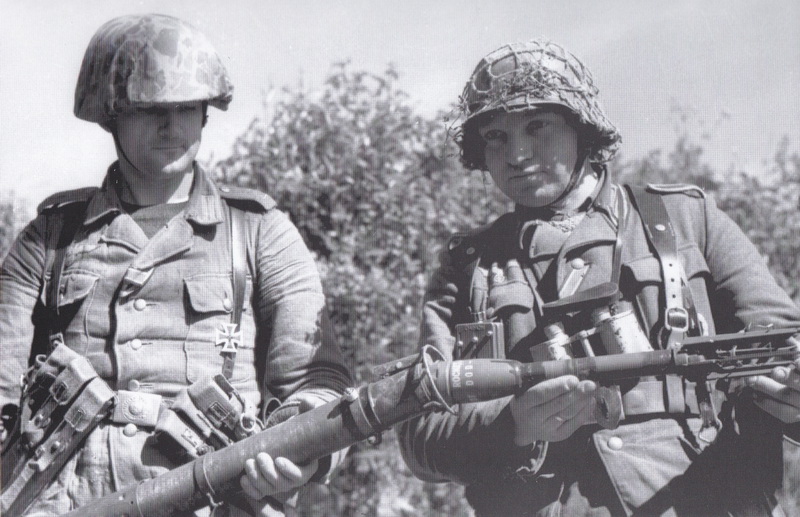Allies
of the Third Reich
Germany
Beside
the obvious fact that the Germans used their own weapon, it is
interesting to see pictures with German soldiers handling the origin of
the Panzerschreck. So let's start with a few pictures of Germans with
the US M1 Rocket Launcher in hand.
This picture taken by the
WaA-prüf is of course
the most significant one. Displaying the
Rocket Launcher with a grenade that was captured in Tunis. With this specimen in hand
the development of the Panzerschreck was started.
This
picture was taken in Italy
in September 1943 by PK photographer Haas. The soldier is carrying two
examples
of the US M1 Rocket Launcher, probably captured during fighting with US
troops
in Italy.
Both weapons are missing the mesh screen.
This
photo is part of a series taken by PK Photgrapher Zwirner in La
Luzerne, St.
Andrč de L’Epine, France June-July 1944. The German soldier and
Unteroffizier
are posing with a captured US M1 Rocket Launcher with
ammunition. Note that
the soldier has added a US
camouflage helmet cover and is using US
lace-up
boots (not visible in this picture.). No evidence so far suggest that
the Germans actually used captured
Rocket Launchers in combat.
Romania
The
Panzerschreck was a product of the Third Reich, but was also made
available/exported to Germany's
allies during WW2. Unconfirmed
sources
claim that Romania
received and used the weapon system. The only proofs I have been able
to find
about this “export” are two pictures taken by the German Propaganda
Kompanie
(PK) photographer Paul Wolf in 1944.
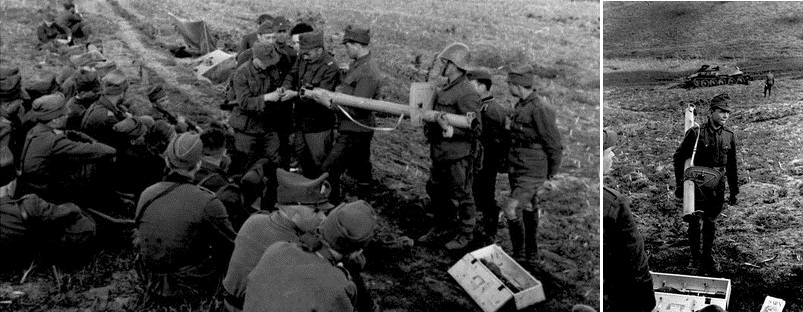
The pictures show German instructors training Romanian
officers and soldiers somewhere south in
the Soviet Union.
The shot up tank in the
background serving as a target is a Soviet SU85, the assault tank
version of
the T34. No further information about Romanian use of the weapon is
known.
Hungary
Hungary had developed a rocket
launcher of
their own, with much closer resemblance to the mother of all rocket
launchers;
the US Rocket Launcher M1. The
Hungarian
version was called Páncélrém
(Tank Fear.) and had
a
calibre of 60mm and a shield resembling the one on the
Panzerschreck.
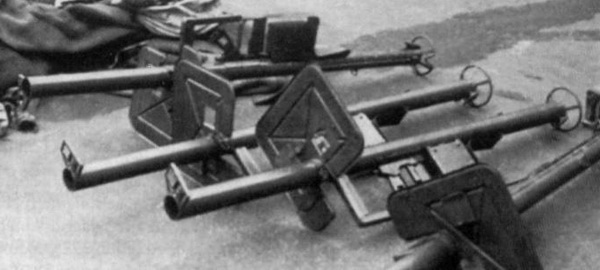 The
Hungarian Páncélrém
The
Hungarian Páncélrém
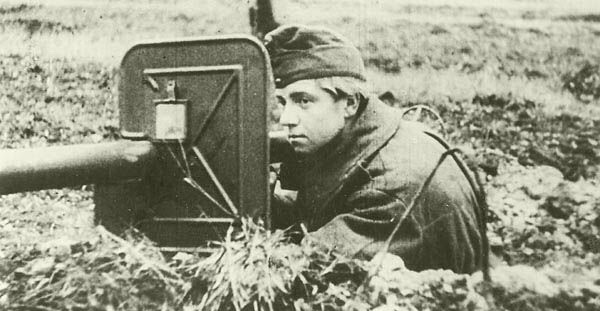
A Hungarian Honvéd with
the Páncélrém in position
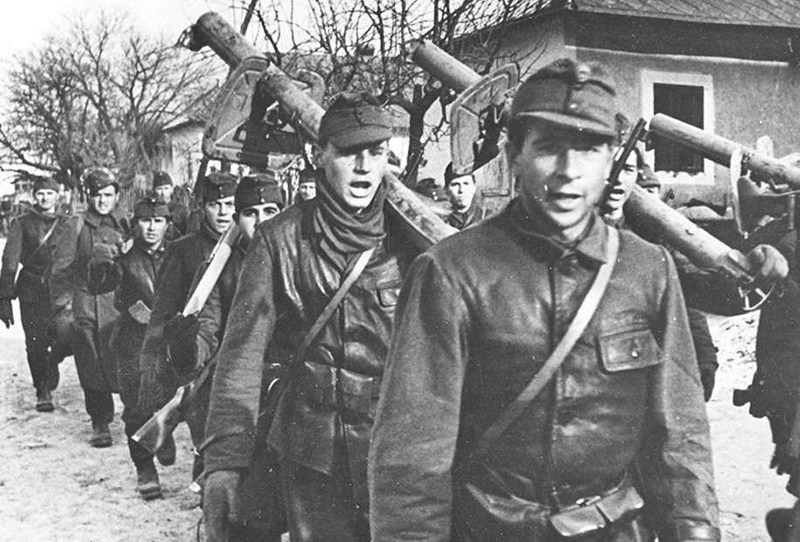
Late 1944. Hungarian troops sing as they march along, heavily armed
with German guns. Picture courtesy of Adam V.
I
haven't been able to find any information about the Panzerschreck in
Hungarian service, but from the picture above it seems likely that they
must have received them, much the same way that the Romanian forces
did.
Slovakia
I have
been informed by "Kurt Faust Mayer" that the Slovak army received 400
Panzerschrecks, called "Pancierový postrach" in
Slovakia. They issued their own anti-tank manual called "Všeobecné
pokyny pre boj proti pancierom všetkých druhov na základe získaných
skúseností na východe" which roughly translates to "General
instructions for fighting all types of armor
based
on experience gained in the East". This also included a translation
of the original German manual to their own language.
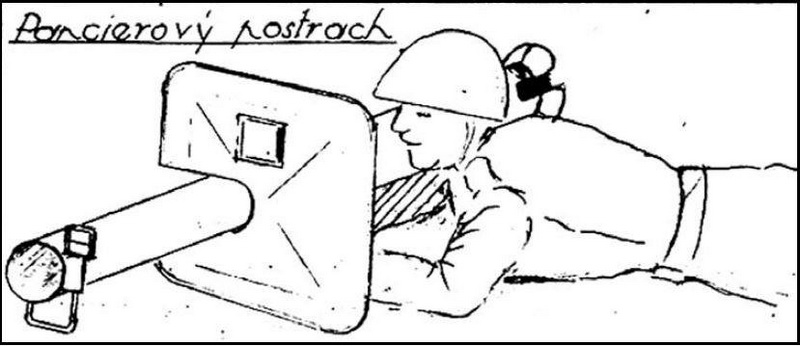
According
to this source there is plenty of written evidence of Slovak soldiers
training with panzerschrecks and panzerfaust but not real evidence of
combat usage.
Some units that were defending east carpathian mountains got schrecks, but they were disbanded due to the Slovakia national uprising in 1944.
By
the end of the war the fanatic Slovak Militia received a large
quantity of panzerschrecks to fight with in the siege of Pressburg.
Italy
Italy was one of Germany's most important
allies until mid 1943. Mussolini's fascist
regime fell on July 25,
1943, and efforts began immediately to arrange
a cease-fire with the Allies. Italy withdrew
from the Axis Alliance on September 8, asking
for, and received, an armistice from the
Allied powers. Germany responded with the raid that freed Mussolini
from his imprisonment at Gran Sasso and established the
Italian Social Republic (Repubblica
Sociale Italiana, RSI)
in northern Italy. The RSI established a Army of their own that fought
alongside the German forces against the Allies in Italy.
The Panzerschreck wasn't even fully invented when the state of Italy
signed the armistice with the allied powers. The RSI army was equiped
and trained by the Wehrmacht. In November 1944 they received
the
Panzerschreck. The number of Panzerschrecks or further details is not
known.
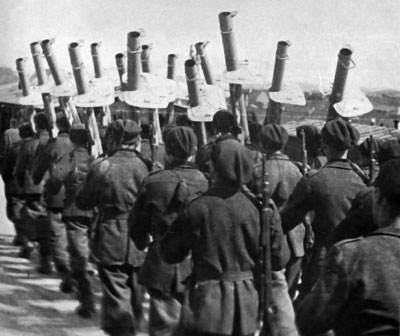
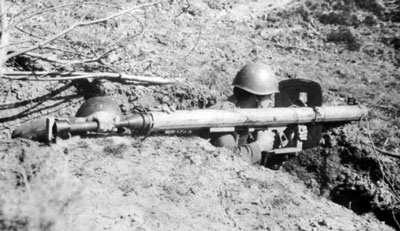
The
above pictures show the RSI army armed with the Panzerschreck. Note the
Bersaglieri with their distinctive hats on the left picture and the
Italian helmets on the right picture. The grenade still has the wooden
handle taped to the drum and would of course not be possible
to
fully load.
FinlandI am able to give you the following information
much due to of the assistance of Jarkko Vihavainen, Finland. His web page is worth visiting for
more information about the Finish use of these weapons. Finland is by far the most interesting German ally
when it
comes to the Panzerschreck. Finland
received several shipments of both Panzerfausts and Panzerschreck with
ammunition during 1944. The Finnish army ordered 2000 Launchers and
20.000
rockets for the grand price of 200.000 Reichmarks. The first shipment
arrived with S/S Aune on 11th April 1944 and was
followed by several
deliveries during the summer. The last batch arrived on 25th
of
August 1944. From
the total order 1854 launchers and 18650 rockets were delivered before
a political change stopped
all arms exports from Germany
to Finland. The weapons
delivered had both types of front sight frame (early/late) and both
types of
safety catch.
The
Panzerschreck in Finish service was named “Panssarikauhu” (Tank
fear/horror).
The official Finish name for the weapon was “88 mm:n raketinheitin
mallia B 54”
, abbreviated to “88 Rakh/B54”. All ammunition delivered to Finland
was the
RPzB Gr 4322 Wintermunition 43/44 type. The official name of the
grenade was
“88
mm:n panssari- h-raketti mallia B-27/30 iskusytytimellä”, abbreviated to “88
psh-rak/B-27/30”. The
Finish army also printed a manual translated from German to Finish that
also
included the
use of two models of the Panzerfaust (listed first on the front page).
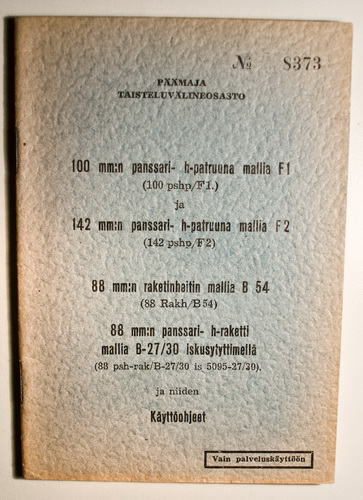
No
(specific Finish) modifications has been found on the Finish used
Panzerschrecks, beside the
added serial number that was positioned on the metal band under the
trigger.
More info about this can be found on the page concerning “Markings, makers,
paint & numbers”. My own Panzerschreck came with a
shoulder pad in leather added to
the original carrying sling, stamped with the Finish army property
mark. All
Panzerschrecks delivered to Finland
was finished in the German Dunkelgelb (tan) colour. In July 1944 orders
was
issued by the Finish army HQ to repaint all Panzerschrecks. All weapons
already
in use were to be repainted by the units, and un-issued weapons should
be
painted prior to being issued. Based on the many surviving examples it
appears
to have been common practice to completely remove the tan paint before
the
Panzerschrecks were repainted in a Finish army green. Some launchers
(most
probably the ones already issued to the units) just got a secondary
layer of
green. The application of a 3-tone camouflage scheme also appears to
have been
widespread. The Finish army green is a thin paint which tends to make
badly
stored weapons rust easily.

The
Finish army property mark was applied to both the launcher and the
shield. It
consists of a large square with the letters “SA” (SA = Suomen Armeijan)
inside
in black, painted on with a stencil. On the actual launcher tube I have
only
observed it applied on top of the Finish green paintwork, normally in
the area
around the trigger.

On the shield
it was positioned to the rear side. Several
shields in original German colour have been observed with the “SA”
property
mark applied directly on the original German paintwork.
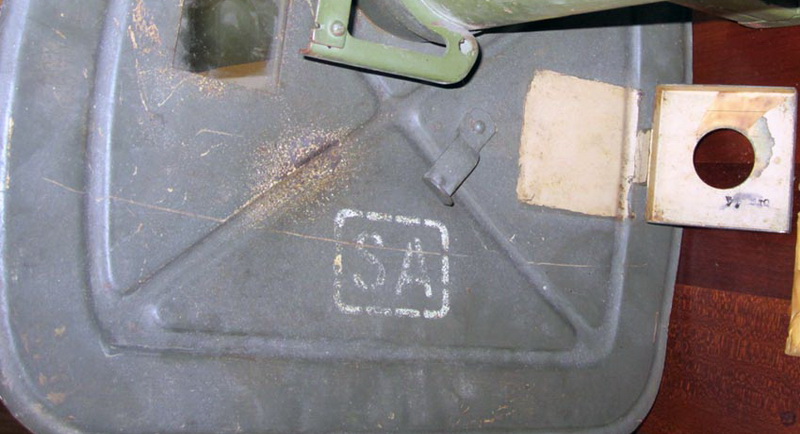
The
above shield is somewhat of a mystery, as it is repainted in Dunkelgrau
and then property marked SA in white. The only explanation I can come
up with is
that it was issued to a German unit in Finland, and then got captured
during or after the German retreat from Finland. And the
Finish army
didn't bother to repaint it, only property marking it. German
units often repainted Dunkelgelb items to Dunkelgrau in the field. But
there are no Finish reports about conquered Panzerschrecks from the
retreating German forces, only Panzerfausts...
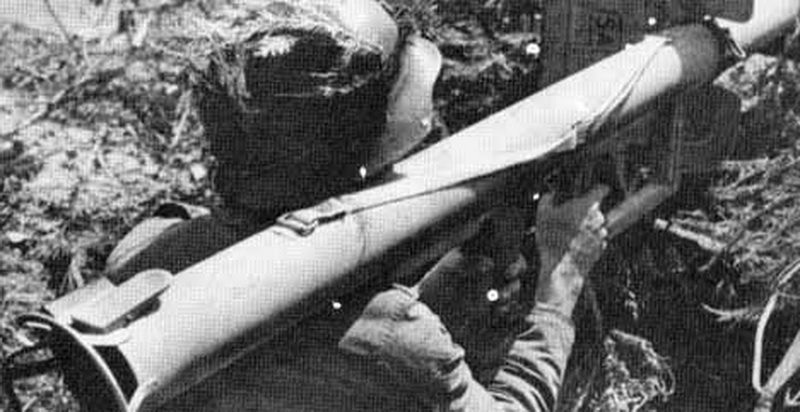
Note
the SA property marking applied on a tan (Dunkelgelb) shield
My own shield
had the property mark applied to the
German tan paint, and then covered again with a 3-tone
camouflage.
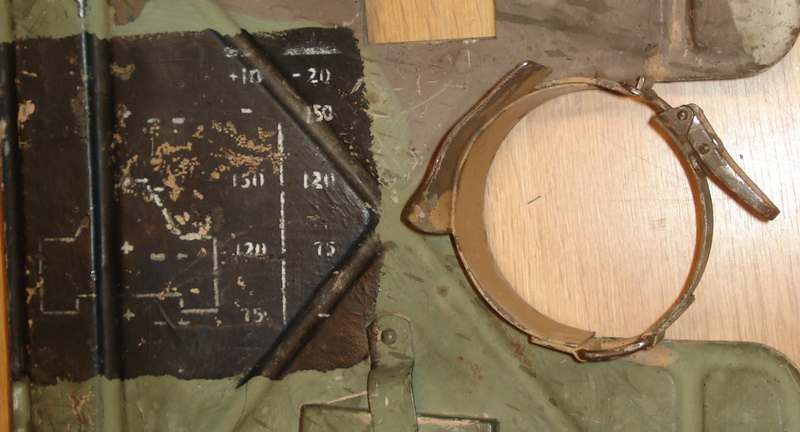
On top of
this, a
quick reference guide for the gunner was painted on the rear side of
this shield
in the form of a T-34 silhouette. The SA marking is behind the
black paint.
At
the end of September 1944 Finland
had signed an
armistice with the Soviet Union and started a military campaign against
the
German Forces in Finland,
forcing them to retreat through Lapland towards Norway.
This is known as the Lapland
war. Several pictures show Finish soldiers armed
with Panzerschreck, with the caption that they display scenes from the Lapland
war. Since the armistice with Soviet Union
was already in place, this would
have been the last combat use of these weapons by the Fins, against
their former owners.
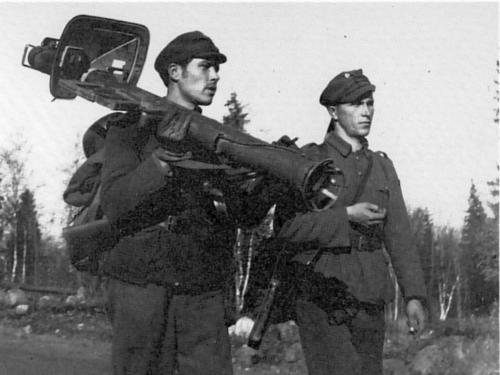
The
Panzerschreck remained in service in the Finnish army until the late
1950’s
when it was placed in storage. The long service time was much due to
the fact
that the SA had plenty of ammunition left when the war ended.
Only 17% of
the German deliveries had been used when the war ended, so they still
had more
than 14.000 rockets left in storage for the cold war era that was to
follow.
The complete stock was bought by
International Armament Corporation (also known as Interarms or
Interarmco) and
was imported into the USA
sometime during the 1960’s. A part of the export apparently
ended up in their warehouse in Manchester, England. The
fate of the ammunition is unknown today, but it was most probably
destroyed in Finland. This
export/import of the Panzerschrecks has turned the market upside-down.
It is
today close to impossible to find a Panzerschreck in good condition in
Europe,
while they are in plenty in the USA. Almost
without exception they will still carry the property markings of the
Suomen Armeijan, with the letters SA inside a square painted on both
the tube
and shield.
Allied
forces
Several
pictures (in fact quite a few) show the Panzerschreck as “war-booty”
and
souvenirs. It must have been considered an interesting/impressive
weapon, as
most photos show the “finder” aiming it, pretending to shoot. So far I haven't heard about any Veteran
bring-backs of the Panzerschreck.
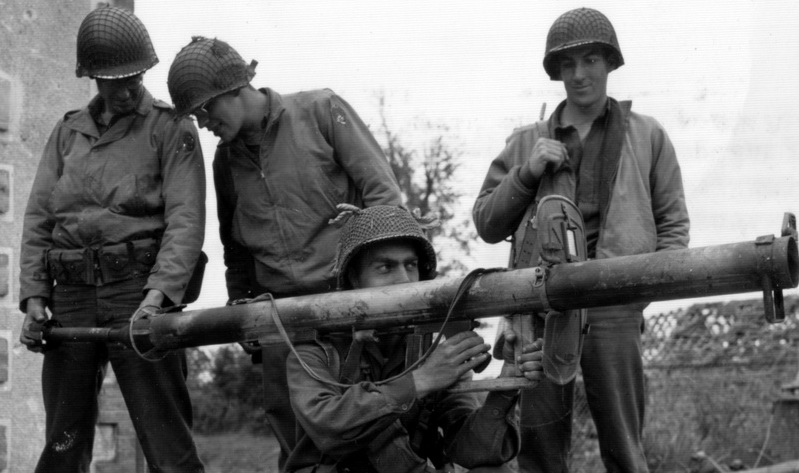
Posing
for a photo. Note that the "gunner" is pulling the wrong trigger.
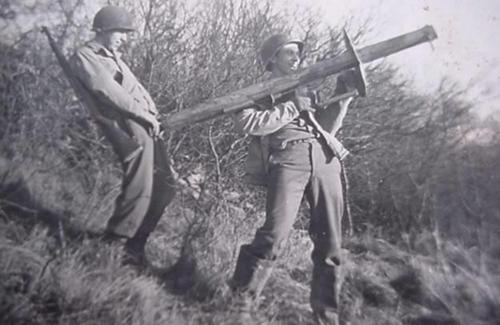
The
Panzerschreck erection.
There
is one photo that claims to show US troops firing a captured
Panzerschreck at a disabled King Tiger to check the actual effect of
the weapon
on armour. According to the picture caption the US Rocket Launcher M1
is also
fired at the same target. The Bazooka was able to penetrate 80mm of
steel, while the
Panzerschreck was listed with a 160mm effect. The frontal armour plate
of the King Tiger is 100mm thick, but it is sloped at 400,
so the effective thickness of the plate would be
153mm
for a shot fired directly from the front. (The dynamics of this will be
explained in the pages about ammunition) It stands to reason that the
Bazooka would merely have scratched the paint, while the Panzerschreck
would have had a theoretical chance of penetrating the King
Tiger
front armour.
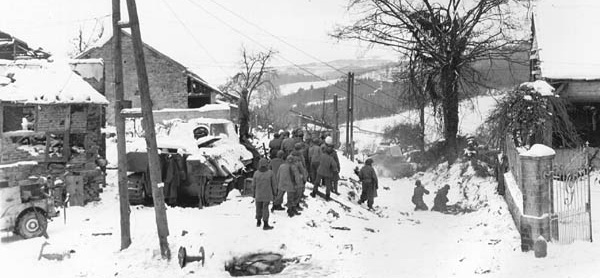
La
Gleize -- Soldiers from the 82nd Airborne Division test fire the
American bazooka and the German Panzerschreck against the frontal armor
of a German Tiger II in January 1945. The Tiger II (officially
Panzerkampfwagen VI Tiger B) belongs to schwere SS-PanzerAbteilung 501
attached to Kampfgruppe Peiper of the 1st SS-Panzerdivision. The
abandoned Panther tank is also part of Kampfgruppe Peiper.
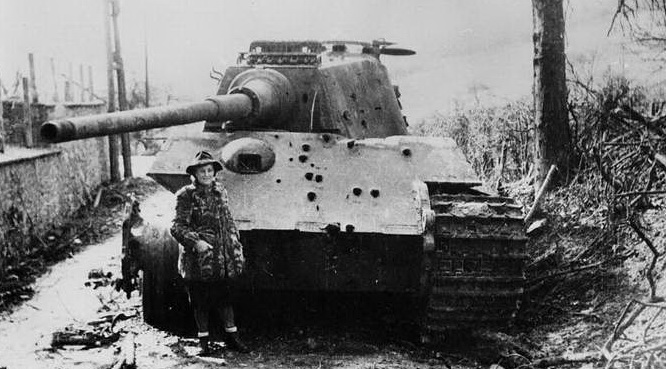
The
very same tank that acted as a target in the previous picture. I assume
this picture was taken in the spring of 1945. According to the
reports none of the rounds penetrated the frontal armor. It is interesting to
see the comparatively small holes from the shaped charges, and to
speculate on which is which...
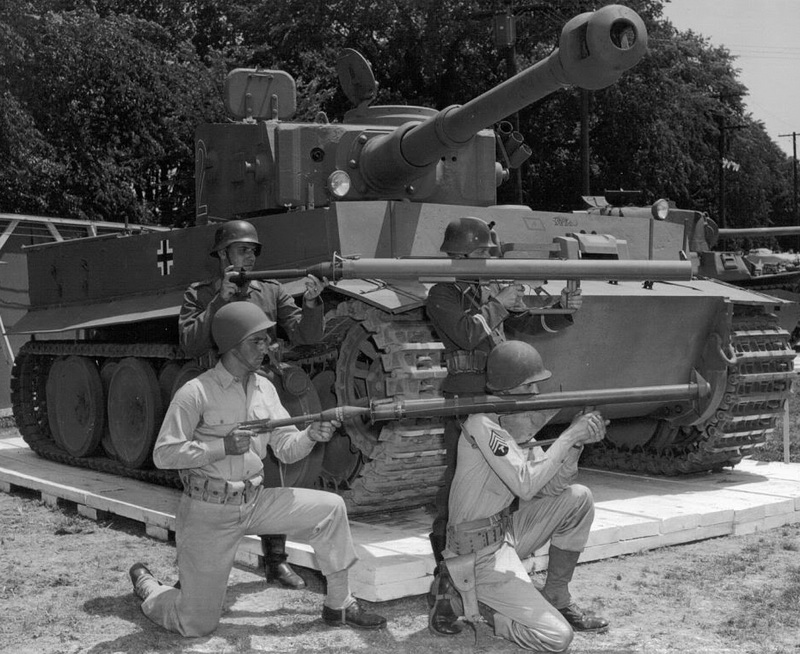 During
1944 and 1945 the Panzerschreck saw alternative service in the US army as part of the
“Weapons of war” exhibit
that toured the United States
to help promote the 5th
war loan. The show displayed US and German weapons and equipment both
static
and in use. This picture is from May 1944. The keen observer would note
that the Panzerschreck firer above has the tunic of a
specialist
supply NCO; "Der Spiess", denoted by the two white stripes on the lower
arm. Also note that the grenade isn't held correctly according to the
manual, during loading.
There
is no proof available that suggest that the Panzerschreck was ever used
in
combat against German forces under any other circumstances than by the
Finns in
the Lapland war.
Poland
An unconfirmed story has come to my attention that suggests that the Panzerschreck
rocket was used by the Polish resistance during the Warszaw uprising
in the Mokotów
district. According to
the known details a former school in the Madalińskiego
area was used by the Germans as a barrack
during the occupation.
On 2. August 1944 the Polish resistance found an ammunition cache of
180 pieces of the Panzerschreck rocket there, left by the Germans
during their withdrawal from certain areas of Warszawa. On the 9.
August the same forces captured a German mobile gun repair workshop.
According to the legend the Polish resistance was able to manufacture a
dozen of (I assume) simplified rocket launchers that would be able to
fire the rocket. In theory, all they would need would be an old
drainpipe and a battery. As stated previously; the "weapon" part of the
Panzerschreck was the actual ammunition. The rockets would have been
excellent to use as remote controlled anti-tank booby-traps etc. For
the fighting inside the city perimeter against
infantry the
grenades would have been less than useful. The grenade has a shaped
charge, and it would have had little effect on "soft" targets such as
infantry and buildings. The Germans used tanks in these fightings, so
the captured Panzerschreck rockets may have
found use. Unfortunately there are no official reports or even any
pictures that can confirm this story.
Many
thanks to Wojciech Andrzejewski
for bringing this story to my attention.
NEW ADDITION
The Soviet Union
The soldiers of the Soviet Union did not
posses cameras, so all
pictures of Soviet soldiers in combat were taken by their own
propaganda photographers. And for propaganda
purposes pictures of Soviet soldiers would seldom show him armed with
fascist weapons, as everything created by the fascists were inferior
and should be destroyed. Some evidence from Russian inteligence reports
suggests that they did indeed study the Panzerschreck, and possibly
used them when they could find them.
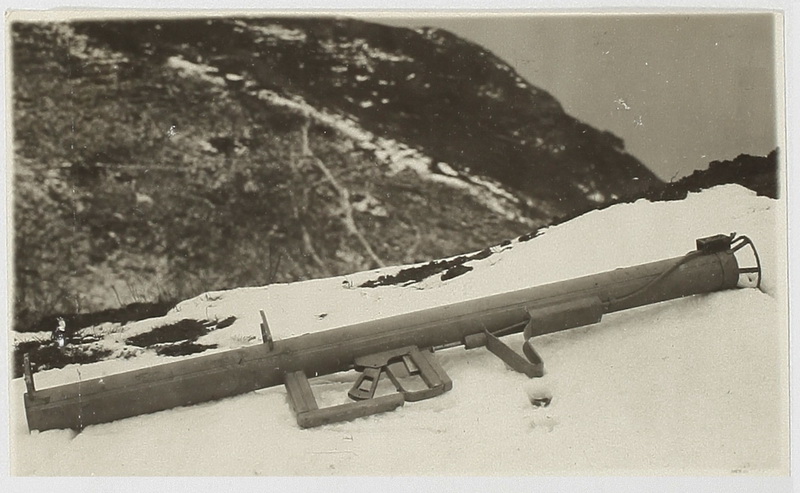
This
Soviet intel photo shows a captured Panzerschreck of very early
production in
pristine condition.
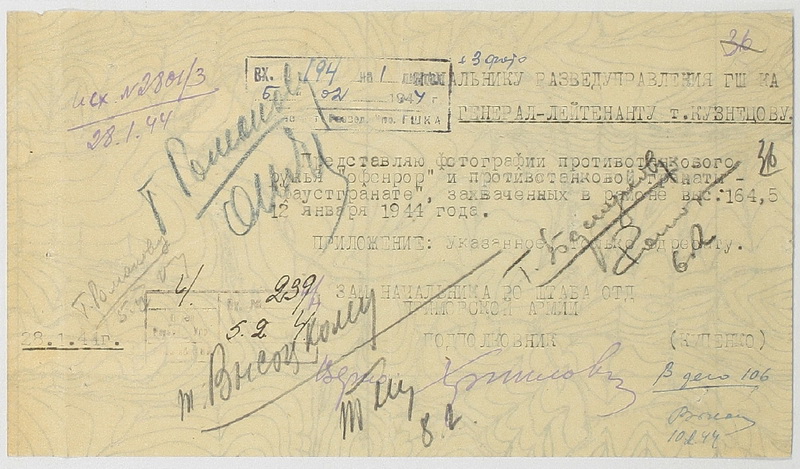
I
am not able to understand much of the writing on the rear, apart from
the two dates; 28. January 1944 and 5. February 1944.
(I am sure some of my Russian speaking readers can translate it.....)
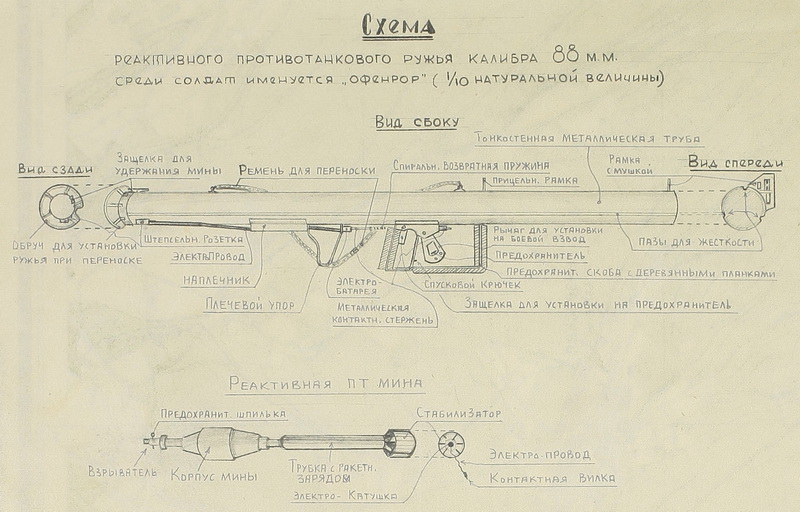
This
drawing was found with some Red Army intelligence reports. The artist
has obviously drawn these pictures from scratch. He has drawn the
object in front of him, as there are no known German illustrations that
looks like this. He has done a very good job, and even noticed small
details like the three grooves in the tube.
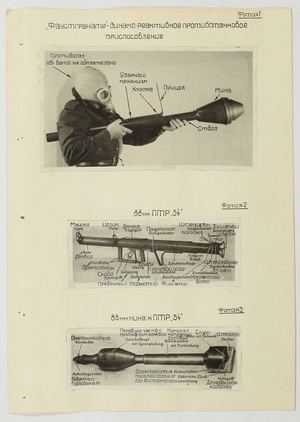 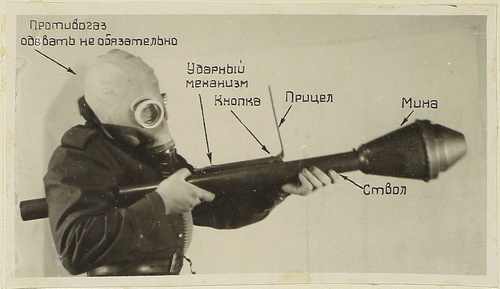
Another
page from Red Army intelligence files. The first picture show a soldier
wearing a Soviet gas mask ready to fire a Panzerfaust 30.
There is
obviously some confusion in regards to the
working principle
of the weapons here. An interogation of a captured German soldier
misinterpreted? The Panzerfaust wasn't rocket powered, it had a simple
black powder charge that propelled the warhead towards it's target.
That is why the steel tube of the Panzerfaust is considerably thicker
than the Panzerschreck. On the other hand the rocket of the
Panzerschreck burns hefty after it has left the tube, and protectional
clothing must be worn by the shooter.

The
last two pictures are nicked from the first Panzerschreck manual, the
D1864/2. The names on the drawings have all been translated to Russian.
|


 The
Panzerschreck in foreign service
The
Panzerschreck in foreign service

